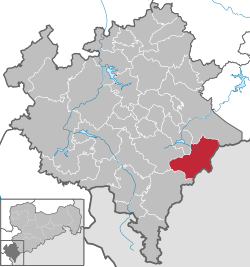Klingenthal
| Klingenthal | ||
|---|---|---|

Centre of the town in winter
|
||
|
||
| Coordinates: 50°22′1″N 12°28′07″E / 50.36694°N 12.46861°ECoordinates: 50°22′1″N 12°28′07″E / 50.36694°N 12.46861°E | ||
| Country | Germany | |
| State | Saxony | |
| District | Vogtlandkreis | |
| Government | ||
| • Mayor | Thomas Hennig (Ind.) | |
| Area | ||
| • Total | 50.44 km2 (19.47 sq mi) | |
| Elevation | 500 m (1,600 ft) | |
| Population (2015-12-31) | ||
| • Total | 8,783 | |
| • Density | 170/km2 (450/sq mi) | |
| Time zone | CET/CEST (UTC+1/+2) | |
| Postal codes | 08248, 08267 (Zwota) |
|
| Dialling codes | 037467, 037465 (Mühlleithen) |
|
| Vehicle registration | V, OVL | |
| Website | www.klingenthal.de | |
Klingenthal is a town in the Vogtland region, in the Free State of Saxony, south-eastern Germany. It is situated directly on the border with the Czech Republic opposite the Czech town of Kraslice, 29 km southeast of Plauen, and 33 km northwest of Karlovy Vary.
The Aschberg ("cinder mountain") towers above the town at 936 m. The extremely elongated town, 10.5 km from end to end, is surrounded by numerous woods of firs.
The town is bisected by the Döbra and Zwota rivers. These two rivers unite at the Czech-German border to form the Svatava river, which in turn flows into the Ohře river at Sokolov.
In 1591, Sebastian Köppel established a hammer mill near the border to Bohemia on the banks of the Zwota in order to capitalize on the rich deposits of iron ore and the region's vast supplies of wood, both for building and charcoal production. On February 1, 1602, there was the first documented mention of the "Höllhammer" (in English approximately: "Hell Hammer" or "Hollow Hammer") in the neighboring town of Schöneck's church register. At that time, blacksmiths, miners and charcoal makers were living there. In 1628, the hammer mill burned down and was only partly rebuilt.
The town fell under the control of Protestants following Swedish victory against Catholic forces at the Battle of Klingenthal, fought in November 1642. In mid-17th century, Bohemian emigrants fleeing the Counter-Reformation brought the luthier's craft to Klingenthal, which - after the Peace of Westphalia - was a safe haven for Protestants.
In 1716, the foundation of a luthiers' guild was celebrated. Towards the end of the 18th century, bow makers' and string makers' crafts came to Klingenthal, but also the production of wood and brass wind instruments. In 1829, mouthharp production followed and in 1852, accordion production began. In the second half of the 19th century, the production of mouthharps, accordions and other more complex instruments had mostly displaced older branches of musical instrument production.
...
Wikipedia



